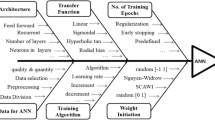Abstract
In the present investigation, the correlation of composition-processing-property for TC11 titanium alloy was established using principal component analysis (PCA) and artificial neural network (ANN) based on the experimental datasets obtained from the forging experiments. During the PCA step, the feature vector is extracted by calculating the eigenvalue of correlation coefficient matrix for training dataset, and the dimension of input variables is reduced from 11 to 6 features. Thus, PCA offers an efficient method to characterize the data with a high degree of dimensionality reduction. During the ANN step, the principal components were chosen as the input parameters and the mechanical properties as the output parameters, including the ultimate tensile strength (\( \upsigma_{\text{b}} \)), yield strength (\( \upsigma_{0.2} \)), elongation (\( \updelta \)), and reduction of area (φ). The training of ANN model was conducted using back-propagation learning algorithm. The results clearly present ideal agreement between the predicted value of PCA-ANN model and experimental value, indicating that the established model is a powerful tool to construct the correlation of composition-processing-property for TC11 titanium alloy. More importantly, the integrated method of PCA and ANN is also able to be utilized as the mechanical property prediction for the other alloys.





Similar content being viewed by others
References
Y.Y. Zong, D.B. Shan, M. Xu, and Y. Lv, Flow Softening and Microstructural Evolution of TC11 Titanium Alloy During Hot Deformation, J. Mater. Process. Technol., 2009, 209, p 1988–1994
H.Q. Chen, C.X. Cao, L. Guo, and H. Lin, Hot Deformation Mechanism and Microstructure Evolution of TC11 Titanium Alloy in β Field, Trans. Nonferr. Met. Soc. China, 2008, 18, p 1021–1027
H.W. Song, S.H. Zhang, and M. Cheng, Subtransus Deformation Mechanisms of TC11 Titanium Alloy with Lamellar Structure, Trans. Nonferr. Met. Soc. China, 2010, 20, p 2168–2173
Y. Sun, W.D. Zeng, Y.F. Han, X. Ma, and Y.Q. Zhao, Optimization of Chemical Composition for TC11 Titanium Alloy Based on Artificial Neural Network and Genetic Algorithm, Comput. Mater. Sci., 2011, 50, p 1064–1069
W.D. Zeng, Y. Shu, and Y.G. Zhou, Artificial Neural Network Model for the Prediction of Mechanical Properties of Ti-10V-2Fe-3Al Titanium Alloy, Rare Met. Mater. Eng., 2004, 133, p 1041–1044
C.L. Philip Chen, Y. Cao, and S.R. LeClair, Materials Structure-Property Prediction Using a Self-Architecting Neural Network, J. Alloys Compd., 1998, 279, p 30–38
A. Bahrami, S.H. Mousavi Anijdan, and A. Ekrami, Prediction of Mechanical Properties of DP Steels Using Neural Network Model, J. Alloys Compd., 2005, 392, p 177–182
Y. Sun, W.D. Zeng, X.M. Zhang, Y.Q. Zhao, X. Ma, and Y.F. Han, Prediction of Tensile Property of Hydrogenated Ti600 Titanium Alloy Using Artificial Neural Network, J. Mater. Eng. Perform., 2011, 20, p 335–340
Y. Sun, W.D. Zeng, Y.Q. Zhao, X.M. Zhang, X. Ma, and Y.F. Han, Constructing Processing Map of Ti40 Alloy Using Artificial Neural Network, Trans. Nonferr. Met. Soc. China, 2011, 21, p 159–165
S. Senthil Kumaran, S. Muthukumaran, and S. Vinodh, Optimization of Friction Welding of Tube to Tube Plate Using an External Tool by Hybrid Approach, J. Alloys Compd., 2011, 509, p 2758–2769
Y. Sun, W.D. Zeng, X. Ma, B. Xu, X.B. Liang, and J.W. Zhang, A Hybrid Approach for Processing Parameters Optimization of Ti-22Al-25Nb Alloy During Hot Deformation Using Artificial Neural Network and Genetic Algorithm, Intermetallics, 2011, 19, p 1014–1019
Y. Sun, W.D. Zeng, Y.Q. Zhao, Y.L. Qi, X. Ma, and Y.F. Han, Development of Constitutive Relationship Model of Ti600 Alloy Using Artificial Neural Network, Comput. Mater. Sci., 2010, 48, p 686–691
H. Sheikh and S. Serajzadeh, Estimation of Flow Stress Behavior of AA5083 Using Artificial Neural Networks with Regard to Dynamic Strain Ageing Effect, J. Mater. Process. Technol., 2008, 196, p 115–119
Y. Sun, W.D. Zeng, Y.Q. Zhao, X.M. Zhang, Y. Shu, and Y.G. Zhou, Modeling Constitutive Relationship of Ti40 Alloy Using Artificial Neural Network, Mater. Des., 2011, 32, p 1537–1541
A. Agarwal, F. Pettersson, A. Singh, C.S. Kong, H. Saxen, K. Rajan, S. Iwata, and N. Chakraborti, Identification and Optimization of AB2 Phases Using Principal Component Analysis, Evolutionary Neural Nets, and Multiobjective Genetic Algorithms, Mater. Manuf. Process., 2009, 24, p 274–281
K. Polat and S. Gunes, An Expert System Approach Based on Principal Component Analysis and Adaptive Neuro-Fuzzy Inference System to Diagnosis of Diabetes Disease, Digit. Signal Process., 2007, 17, p 702–710
K. Polat and S. Gunes, Artificial Immune Recognition System with Fuzzy Resource Allocation Mechanism Classifier, Principal Component Analysis and FFT Method Based New Hybrid Automated Identification System for Classification of EEG Signals, Expert. Syst. Appl., 2008, 34, p 2039–2048
K. Swingler, Applying Neural Networks: A Practical Guide, Morgan Kaufman Publishers, Inc., San Francisco, CA, 1996
C.H. Dong, Artificial Neural Network and Application with MATLAB, National Defense Industry Press, Beijing, 2005
K. Hornik, M. Stinchcombe, and H. White, Multilayer Feed Forward Networks are Universal Approximators, Neural Netw., 1989, 2, p 359–366
Acknowledgments
The authors are grateful for the financial support given by the Major State Basic Research Development Program of China (973 Program) under No. 2007CB613807, the New Century Excellent Talents in University under No. NCET-07-0696, and the National Natural Science Foundation of China under Grant No. 51075333.
Author information
Authors and Affiliations
Corresponding author
Rights and permissions
About this article
Cite this article
Sun, Y., Zeng, W., Zhao, Y. et al. Modeling the Correlation of Composition-Processing-Property for TC11 Titanium Alloy Based on Principal Component Analysis and Artificial Neural Network. J. of Materi Eng and Perform 21, 2231–2237 (2012). https://doi.org/10.1007/s11665-012-0162-y
Received:
Revised:
Published:
Issue Date:
DOI: https://doi.org/10.1007/s11665-012-0162-y




